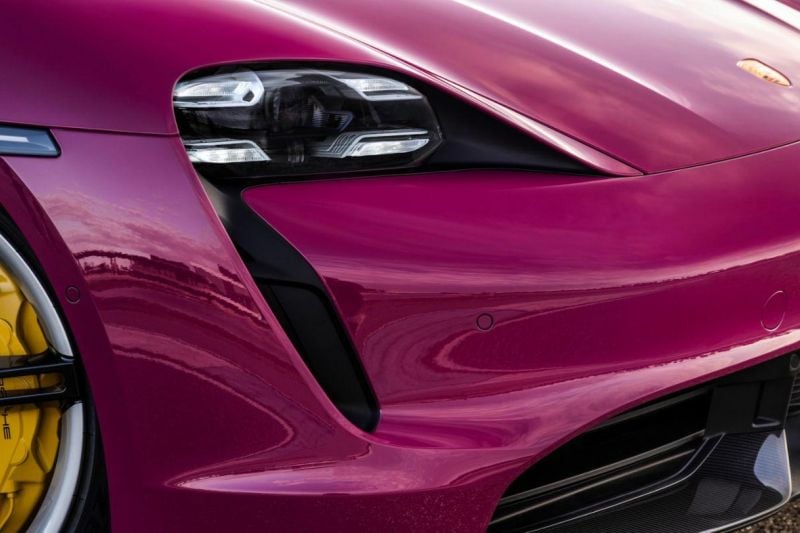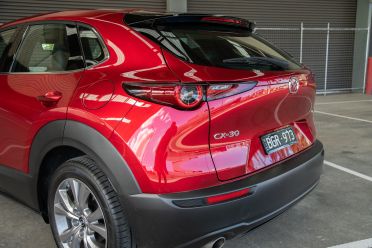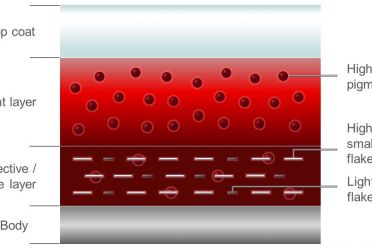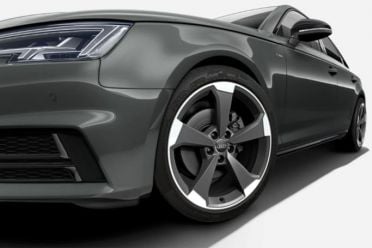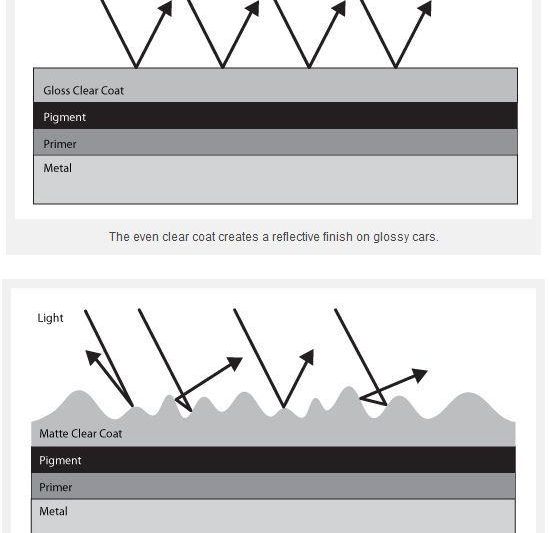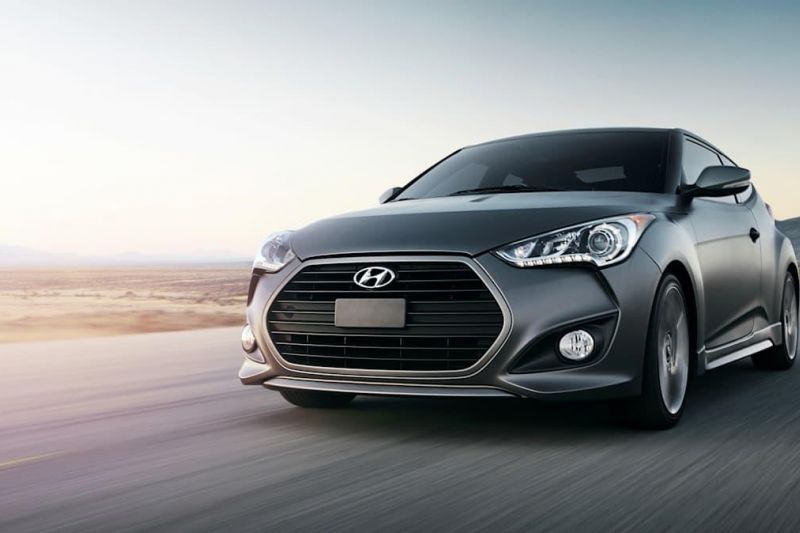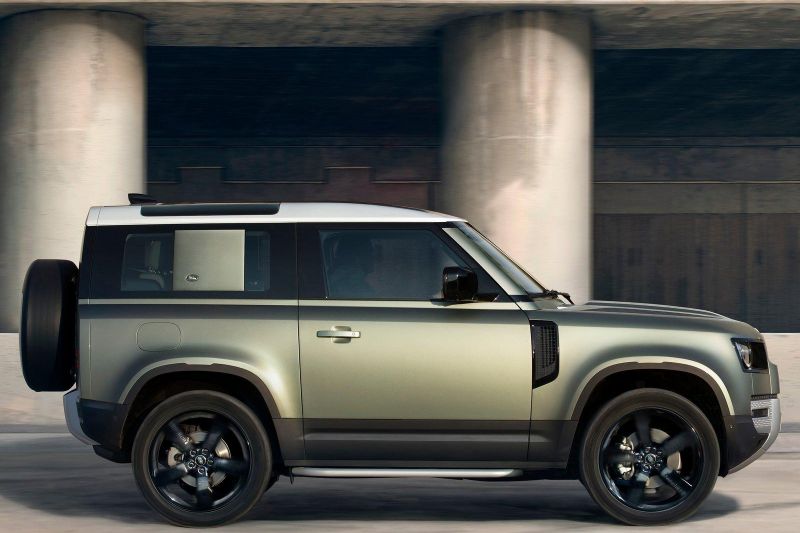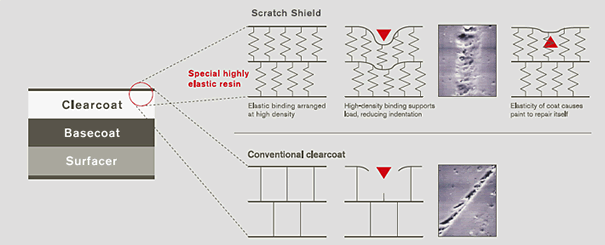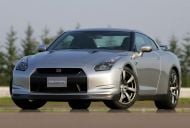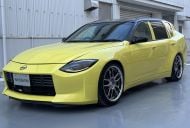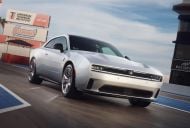Cars can be an expression of ourselves. They represent our identity and our aspirations. Correspondingly design and styling are key elements we consider when making a purchase.
Paint is one aspect of a car that can significantly influence our perception of its design. Certain shapes can look great in a particular colour combination, whilst others might hide styling elements and work to its detriment.
Automotive paint not only has a styling and design function, it also serves a protective purpose. To this extent it is composed of multiple layers.
Once the body-in-white has been finished and treated, an initial e-coat (electrically applied coat) protects the car from corrosion. A primer layer then minimises the impact of stone chips, provides UV protection, and serves as a uniform base to which colour can be added.
After these colour layers are added, the painting process is finished with a transparent lacquer or clear coat. This adds some scratch resistance and protection from environmental damage such as residue from tree sap, bugs etc.
Apart from the colour of the paint, another consideration is the finish. The standard today is a solid finish, describing a flat paint that has the same appearance in all lighting conditions. Other common finishes include glossy metallic or pearlescent paint (also known as mica).
Some manufacturers, especially luxury marques such as BMW, Jaguar Land Rover and Genesis, have begun introducing satin or matte paint finishes into their palettes. This type of finish brings its own stunning look that can differentiate a car from other vehicles on the road.
These finishes generally involve modifications to the paint layers described above. This is done either through the use of additional colour layers, or the addition of materials such as metal or ceramic particles within the colour layer. In some cases, the added materials form their own distinct layer between the colour and the clear coat.
Altering these layers changes the way the paint interacts with light, and thereby enables car makers to produce paint finishes with distinct visual effects.
Metallic paint
Metallic paint is probably the most commonly available alternative to a standard solid finish. Traditionally used on sports cars, this finish is now available across the market.
As the name suggests, metallic paint is differentiated from solid paint through the addition of metal flakes. These are generally aluminium particles that effectively act as micro-mirrors to reflect light striking the car. This has the effect of producing a consistently shiny appearance that adds sparkle.
Some manufacturers have taken this one step further.
Mazda’s Soul Red Crystal Metallic uses two types of flakes – one that reflects light and another that absorbs it, in addition to a high chroma pigment layer. Mazda claims this increases reflectivity and colour saturation, whilst allowing the paint to subtly shift tone from a deep crimson to a ruby red depending on lighting conditions and the angle that the car is viewed at.
Pearlescent paint
In contrast to the reflective aluminium flakes used in metallic paint, pearlescent paint makes use of artificial ceramic crystals, also known as mica crystals. Cars using a pearlescent paint option may use one teaspoon or more of mica crystals per litre of paint.
Mica crystals have the dual properties of not only reflecting light, but refracting (bending) it. It’s a similar fundamental principle to how rain splits sunlight to create a rainbow, or how a glass prism can disperse white light into different colours on the spectrum depending on its angle.
Automotive paint applications use this basic principle to not only reflect light, but also shift the base paint colour, creating a lustrous glow that can reveal hidden shades of colour depending on the environmental conditions – like whether the car is being seen in bright sunlight or on a cloudy day, and the angle it is being viewed at.
These hidden tones mean pearlescent paint can accentuate design details such as a character line, or a particular curve used on the side profile of the car.
Less common than metallic paint, pearlescent options have greater availability amongst premium marques and may add a slight premium over their metallic counterparts. The presence of mica crystals may also mean that this paint option is more difficult to repair.
Matte paint
Matte paint differs by offering a flat, satin effect sheen rather than a glossy finish.
Whilst the paint’s base and colour layers remain similar to glossy paint finishes, the satin effect primarily originates from differences in the clear coat layer.
In glossy paint a smooth clear coat is used to uniformly reflect light. In comparison, matte paint makes use of a rougher clear coat with small dimples and other imperfections. The texture enables light to be scattered and diffused in different directions, leaving a distinct matte appearance.
Whilst matte paint is increasing in popularity, it remains a niche alternative. Not only is it significantly more expensive, it generally requires specialised care and may be more susceptible to environmental factors such as stone chips, tree sap and other organic residue.
Although offered on cheaper models such as the superseded Hyundai Veloster, the added cost of matte paint generally means that availability is limited to higher-end models from luxury car brands – such as Mercedes-Benz, Jaguar Land Rover, Genesis and BMW.
Wraps: How do these compare to paint?
A wrap is generally a much easier way to alter how your car looks than repainting it.
Much like how clear contact is used as a covering for A4 exercise books at school, wraps are vinyl coverings that go over a car’s paintwork. An installer will cut the covering into shapes to fit the body panels (a car can be wrapped completely or just partially), and use a heat gun to remove wrinkles or bubbles.
There are two main types of vinyl vehicle wraps available: cast and calendared. When wrapping your vehicle, be clear on the type being chosen. A calendared wrap may be cheaper, but its thickness compared to a cast option means it may not have the same precise fit.
Wraps are available in glossy and matte finishes, and are far easier than paint to customise with unique designs, patterns or logos (much like creating and printing a sticker). This makes them especially suitable for advertising purposes or for those who would like a relatively affordable way for their car to stand out.
They can be removed and replaced with little to no damage to the underlying paintwork, and also provide an additional layer of protection from the elements.
Wrapping a car is generally done in the aftermarket, however some vehicles such as the new Land Rover Defender are now being offered with a ‘satin protective film’ that effectively acts as a protective wrap.
Other developments
Noticed a minor scratch on your new car’s paintwork? If it is equipped with self-healing technology, there’s no need to worry. Commercialised by models such as the 2007 Lexus LS, self-healing paint incorporates a special, softer clear coat that can be moulded by heat.
So as long as the scratch is within the clear coat, leaving the car out in direct sunlight or using anything from a hair dryer to warm water will give the molecules enough energy to rearrange themselves to a scratch-free condition.
ChromaFlair is another paint technology available on higher-end cars, such as special paint colours from the SV Bespoke Premium Palette for Jaguar Land Rover (JLR) models. By embedding aluminium flakes (which are also coated in magnesium fluoride for a glassy appearance) within a distinct chromium layer, greater colour shifts are achieved.
Many manufacturers including Porsche, Rolls-Royce, Bentley, JLR and others offer a match-to-sample paint service. Whilst expensive, this allows the customer to bring in an item in their favourite colour, e.g. a handbag or piece of clothing, and the car maker will create a unique paint colour that matches.


